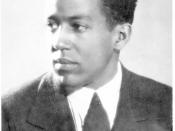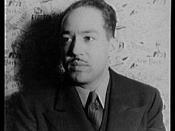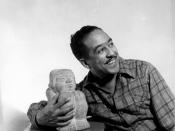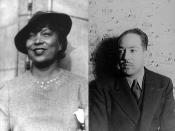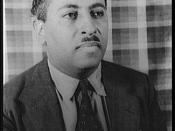Lately, there has been a fascinating trend in publishing circles. More and more firms are showing an interest in releasing the collected letters of famous writers. Possibly, it is due only to a feeling that presently this is good business, since the public recently has shown so much interest in the confessional side of the arts. One can hope, however, that there is more behind the trend. Perhaps it is not out of the question that there does now exist a growing reading public which has discovered how much their understanding of an artist and his work may be enriched through this kind of book.
Of the current group of such books, the one which contains the letters exchanged between Arna Bontemps and Langston Hughes may be the most significant. Not only can it enrich one's understanding of two of the foremost Afro-American writers, but it also can provide one with new insights into both the hostile social and political background against which they had to struggle in the United States, and the rich cultural tradition which they exemplified and encouraged both here in their country and in other parts of the world.
In other words, their letters ultimately come to represent not only their personal legacy but also that of an oppressed minority fighting for a distinctive and free voice.
When these two men first met in 1924, they were struck by their common desires. As a result, they began to correspond soon thereafter, and this correspoondence did not stop until Langston Hughes died in 1967. By then, the two had written approximately twenty-three hundred letters to each other. Charles H. Nichols, the editor of this book, has selected five hundred of these, and although one has to be curious about the letters that have been left out, it is easy to recognize the value of the ones which are presented.
Through them, the reader certainly gets a feeling for the authors which they might not otherwise have. Both Bontemps and Hughes, like so many writers, had various personae which they employed for different audiences. In most of their letters, they still appear to be restrained by the awareness of an audience, particularly after they agree that their letters would eventually be collected and housed at the Yale University library. Nevertheless, once in a while, they let some of their more private feelings through; and, because this is not very often, such moments appear that much more intense and moving. Perhaps the most affecting examples of these come early in their careers when, as they are forced to face the great odds of establishing themselves as black voices in a white society, they occasionally give in to feelings of despair and, in turn, encourage each other to continue the struggle.
While they work to fulfill their personal and racial missions of artistic freedom, they often record the most significant literary, social, and political events that were occurring around them. Since they often do this merely in passing, this book should not be perceived as more than it is. It is not a history of ideas or world events. On the other hand, it can serve as a barometer of the turmoil of half a century. Thus, for example, as one reads the letters written during World War II, one gets glimpses of exactly what effect this upheaval had on promoting the race struggle in the United States. After the war, and prior to the revolutionary period of the 1960's, there are absorbing references to such issues as the Negro press, black athletes, birth control, film as an educational tool, the need for black consciousness, and the oppressive climate of the racist South. Then, during the 1960's occasional comments on the Civil Rights Movement give one an impression of what it was like for a black person, and more specifically a black intellectual, to live in that explosive period.
Being literary men, it was literature that was of primary interest to Bontemps and Hughes. Consequently, their letters are packed with comments on fellow writers and literary trends. Often, again, these comments are only in passing. Once in a while, however, the opinions which they exchange have critical value. Both Bontemps and Hughes, belonging to a generation of writers identified with the Harlem Renaissance, were, first of all, deeply interested in the career of anyone who stemmed from that tradition. Thus, frequently they exchange information and concerns about such writers as Claude McKay and Jean Toomer. In the case of the latter, Bontemps at one point throws out the intriguing view that Toomer might have failed in his desperate attempt fo follow up on the success of his experimental work, Cane, because he decided to write no longer as a black.
Although both writers may have had a stake in the preservation of the older Afro-American literary tradition, they were very much aware of whatever was new. In fact, they both encouraged new black talent wherever they found it. It may still be too early to tell exactly how deep and lasting their influence on the history of Afro-American culture will ultimately be, although it is bound to be profound. There seems to be no question, however, that without their example and encouragement several of today's most important living black writers would have had a harder time getting recognition. Bontemps and Hughes collaborated on several books, and some of them were anthologies. Because they were always careful to include new talent in these anthologies, several young writers had exposure precisely when they needed it for their careers to take off. Furthermore, Bontemps, in particular, took great pleasure in writing reviews in which he hailed the first works of major, new black talent. Gwendolyn Brooks, Frank Yerby, and Ralph Ellison are only three of these writers who were thus publicized.
At times, it seems that, between the two, Bontemps and Hughes knew or met practically every American writer of importance living during their time. At least, this is true when it comes to black writers. Their acquaintances ranged from W. E. B. DuBois to Richard Wright and James Baldwin. One regrets that when they write about such authors, the commentary is usually tantalizingly brief. Still, now and then, there is real substance. In the case of Baldwin, for example, Hughes writes that Go Tell It on the Mountain would have been a wonderful book if it had had more affirmative feeling and less self-conscious art. In other words, if it had more of the feeling for folk character and idiom which can be found in the works of Zora Neale Hurston, it might have been a great book.
Such critical comments give some insight into what kind of literature both men fundamentally stood for: a literature which looks back to the folk tradition of the Afro-American experience. Yet, while based on the past, literature encourages experimentation with folklore, jazz, and spontaneous style; and while based on the painful ordeal of the past, it encourages a vision of hope. Given this perspective, it is no wonder that Bontemps would reserve some of his most aggressive words for the New Criticism represented by such writers as T. S. Eliot, Ezra Pound, and The Fugitives. As far as he was concerned, these people were "a sick lot."It should be emphasized at this point that this comment cannot be taken as simply a racial one. Actually, both Bontemps and Hughes, although primarily concerned with Afro-American literature, were interested in all kinds of good writing. Both, for example, had great affection for such white authors as Carson McCullers and Katherine Anne Porter. And, in keeping with their great interest in the theater, they shared enthusiastic views about Tennessee Williams when his works began to appear.
After Bontemps and Hughes had established their own careers here in the United States, they began to become increasingly international in their activities. Hughes started to travel widely and to spread his influence as far as Japan and Russia. Bontemps, always a more serious reader than his friend, began to comment more and more on literature of South America, Africa, and the Caribbean. Today, as a result, the Afro-American movement in literature is often perceived as the leader of an international trend which, at least in many parts of the world, has overwhelmed the modernist aesthetic tradition.
Obviously, because of the primary emphasis on literature and fellow writers, this book of letters is not for everybody. Yet, the two men occasionally exchange little stories that would delight anyone. One of the on-going jokes between them concerns the fact that they resemble each other so much that they are constantly mistaken for each other, even over the phone. During the war, they enjoy sharing the rumor that Hess had killed Hitler. Once Hughes writes to tell Bontemps that at Fisk, where the latter was then the librarian, there was someone who falsely was claiming to be Ralph Ellison's son. Then, having become something of a celebrity, Hughes complains to Bontemps about finally being forced to answer a Mississippi lady after she had written him 103 letters. Perhaps best of all, there is the story about Hughes sitting in the audience listening to Arthur Koestler recalling during the course of his speech how he had once met the "great Negro poet" before he died.
These lighter moments illustrate that the writers had a sense of humor, an appreciation of the absurd, which is all the richer when set against their very serious obsession. For there is no doubt they were obsessive men. Both worked without rest up to their very last days for basically one purpose. This purpose was not merely for fame, and certainly not for money. It was, instead, to create and encourage nothing less than a vital culture. In the last two letters in this volume, Bontemps writes in a mood of exhilaration which indicates that perhaps they have lived to see the fulfillment of their dream; since looking back to the 1940's, he could see how much had subsequently happened, reaching the point where in 1967 there was actually "an explosion of interest in Negro poetry."For the scholar of Afro-American literature, this book might prove to be indispensable. For other readers, however, the book may not mean as much. One problem for the general reader is that Bontemps and Hughes refer to so many people, often very briefly, that even a well-read person is bound to be hard pressed to know who they all are. It is unfortunate that the editor of the book did not believe it incumbent upon him to do at least some limited annotating.
The book has some other problems, too, one of which concerns the editor's selection of letters. It is clear why the letters he chose are present. He should, however, have given some indication why the other eighteen hundred are left out, and what readers have missed as a consequence. Another, less significant, problem concerns what appears to be a current epidemic, the poor state of editing and proofreading. There are times when the book suffers gratuitously because of sporadic dating, haphazard grammar, and unexplained ellipses in the chronological arrangement of the letters. Finally, the editor, after writing a helpful prologue, ends with an epilogue in which he needlessly overstates the comparison between black literature and the Beat writers. Worse, he tends to force and overstate his claims for the accomplishments of Bontemps and Hughes.
This he need not have done, since all one has to do to be reminded of their importance is to glance at the chronology of their lives provided toward the end of the book. There one will see that these prolific authors published a combined total of more than fifty books and that several of these are recognized classics of Afro-American literature. No two persons, in short, have ever meant more to this literary tradition. Thus, this book of letters will have achieved its most important accomplishment if it stimulates people to pick up some of Bontemp's and Hughes's works in the future.
BibliographyBerry, Faith. Langston Hughes: Before and Beyond Harlem. New York: Wings Books, 1995.
Bloom, Harold, ed. Langston Hughes. New York: Chelsea House, 1989.
Chinitz, David. "Rejuvenation Through Joy: Langston Hughes, Primitivism, and Jazz." American Literary History 9 (Spring, 1997): 60-78.
Cooper, Floyd. Coming Home: From the Life of Langston Hughes. New York: Philomel Books, 1994.
Harper, Donna Sullivan. Not So Simple: The "Simple" Stories by Langston Hughes. Columbia: University of Missouri Press, 1995.
Haskins, James. Always Movin' On: The Life of Langston Hughes. Trenton, N.J.: Africa World Press, 1993.
Hokanson, Robert O'Brien. "Jazzing It Up: The Be-bop Modernism of Langston Hughes." Mosaic 31 (December, 1998): 61-82.
Leach, Laurie F. Langston Hughes: A Biography. Westport, Conn.: Greenwood Press, 2004.
Mullen, Edward J., ed. Critical Essays on Langston Hughes. Boston: G. K. Hall, 1986.
Ostrum, Hans A. A Langston Hughes Encyclopedia. Westport, Conn.: Greenwood Press, 2002.
Rampersad, Arnold. The Life of Langston Hughes. 2 vols. New York: Oxford University Press, 2002.
Tracy, Steven C., ed. A Historical Guide to Langston Hughes. New York: Oxford University Press, 2004.
